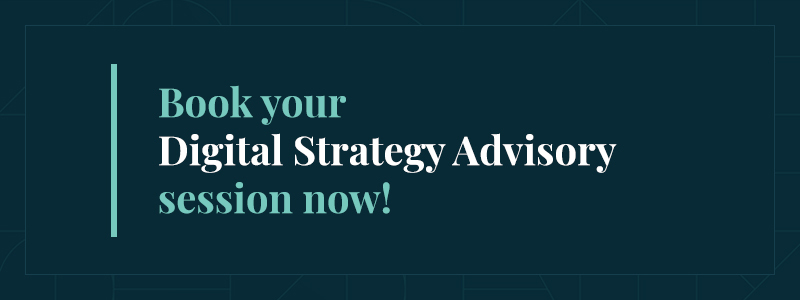Creating a plan that’s ambitious enough to inspire (always aim high!) but practical enough to implement and quantify, is a challenge every business owner faces.
This is where setting SMART Goals can help you create a digital strategy that achieves results.
But first, what is a SMART Goal?
Goals are an important part of every aspect of a business and provide a necessary sense of direction, focus, and significance.
By setting goals, you are providing your business with objectives and targets; SMART goals take that one step further.
SMART is an acronym that stands for Specific, Measurable, Achievable, Realistic, and Timely.

Specific: Your goals should be clear and answer the 5 W’s (who, what, when, where and why).
Measurable: The goals should have specific criteria that can be measured to determine accomplishments
Attainable: The goals needs to be realistic and achievable.
Relevant: Your goal should relate to your overall business goals and factor in current trends in your industry.
Timely: Your goal should have an end date.
As a result, a SMART goal incorporates all of these criteria to help focus your efforts and increase the odds of achieving that goal.
So, where do you begin? Here are a few pointers to help you set your goals for your business.
Start by reviewing the last twelve months
Before you set goals for a new year, it’s important to review the past year – what you achieved, what you didn’t and why. Were you serving your ideal customer? Were there risks that could have been avoided? Were there missed opportunities?
Write down all the goals you had and milestones on one document (Google docs or Excel sheets work fine) and then take a moment to review the successes across the whole year as well as areas that you think require improvements.
This gives you the motivation to take into your evaluation for next year’s plan.
Many small business owners get so caught by the details of running a day-to-day business that they forget the reason why they started – the unique value proposition which they offer customers.

Before you can create new goals, you need to understand who your customer is, what value proposition you offer to customers, what your competition is currently offering in the market and where there are gaps for a new entrant. In other words, you need to do some market research as well.
Think about your vision for the business
When planning your goals they must fit into the overall vision you have for the business. Any goal or strategy that you implement should align with the larger vision of the business and contribute in the long run.
Remember the 5 W’s when considering your business’s overall vision.
This provides a good starting point for planning all your goals and allows you to assess whether your overall vision seems outdated for your current needs or requires adjusting.
Set your twelve-month goal
Before we jump into any new goals for the year, we first need to create the financial goal for the business. Setting your financial goal is an important step toward growing your business and becoming financially secure.
The ultimate objective in any business is higher revenue, but cost reduction has diminishing returns and organic growth has its limits, so acquiring a healthy, cash-flow can lead you to positive earnings.
One way of creating your financial goal is by reviewing the Life Time Value (LTV) or average revenue of your ideal customers and then forecasting your acquisition goal for the coming year.
LTV can help define several economic decisions in a business including marketing and sales budget, resources, and profitability.

Once you have your financial goal, you can work on your other major goals for 2022 – you can break them into monthly, quarterly or even year-end goals depending on your resources and business model if that’s easier for you.
Remember, completion of these goals should be a clear signal that you’re getting closer to achieving your vision.
And because these are SMART goals, each of them should have specific criteria that can be measured to determine the success rate.
Say you have some form of marketing leads growth or customer retention goals? Whatever you decide on, they should have quantitative measures to track them.
For example, “60% repeat customer ratio” as a goal is much easier to measure than “Deliver good customer service.’
Set up a brainstorming session for strategic initiatives
Once you have your goals in order, it’s time to start thinking of strategic initiatives that will help you to reach your goals.
An ideal way to do this is to focus on creating 3 main critical success factors (CSF). These are best described as the means and/or desired results, as well as the action.
Here are a few examples:
- Increase market share through existing customer base
- Double new organic sales leads
Consider conducting a SWOT Analysis of your business to help you with this. A SWOT analysis is a strategic initiative that helps you understand your business’s strengths, weaknesses, opportunities and threats.
The outcome should increase your value to your customers and differentiate your business from the competition.
If you work solely on your own, it may help you to sit with a professional strategist to review your goals and define a strategy to work on that focuses on multiple projects for that year, which in turn will add up to realizing the annual goal.
If you complete your strategic initiatives, you’ll be on the road to achieving your annual goal.

The Digital Strategy Advisory Sessions provide you with the best in digital expertise from experts in the field.
Prioritise initiatives
While it would be great if we could work on every strategic idea we have, the reality is that most businesses have limited time and resources.
Because of this, you will need to prioritise the strategic initiatives you have created in order of importance and benefit to your business.
Focus on your CSFs, and everything else should follow after in order of importance and requirement in the business.
Fill in the knowledge gap
Based on the CFSs, it’s not uncommon to find yourself uncertain about many areas of the business. Especially if you feel there might be a significant knowledge-based gap that’s causing the problem.
One way to get over these hurdles is to keep yourself up to date with the latest news, skills and tools for your business.

Whether it’s attending a workshop, reading e-books or blogs or even online webinars, continuously learning will not only help your business to grow but you as well.
Review your goals
Finally, to avoid your goals from being put in a drawer only to collect dust and be forgotten about, track your progress with KPIs and set a date to review them.
In addition to that, make sure you have a process for making changes to your plan as the year progresses.
Adjusting goals (depending on whether you were overshot or undershot) shouldn’t be perceived as negative – it’s compulsory to keep moving forward.
Key areas to measure include:
- Qualified leads
- Website traffic
- Revenue growth
- Customer satisfaction
- SEO
Conclusion
Creating new goals for your business takes time. Don’t waste hours listening to opinions about what you should be doing or what may or may not work.
Instead, focus on getting data about previous goals, create budgets, consider your resources, and make smart decisions on where you want your business to be next year.
It’s important to stay motivated, follow through with your plans and focus on the task at hand to achieve success.
Originally published Dec 9, 2019, updated August 01 2022

Your first step to building a world-class website starts here.
A trusted brand is priceless for any business. We will help you build a compelling website that is respected in your industry and stands apart from your competition.



